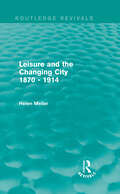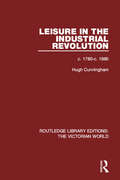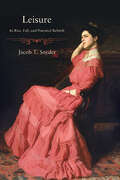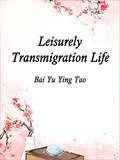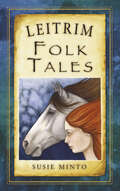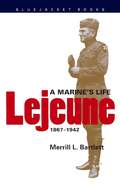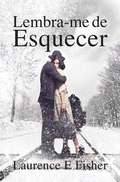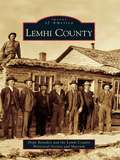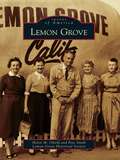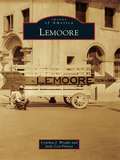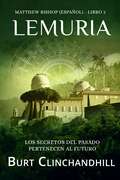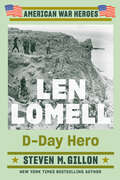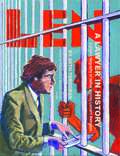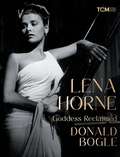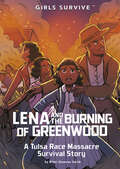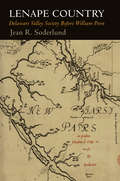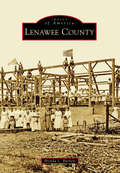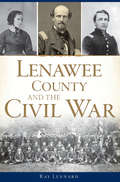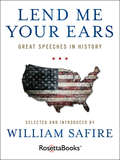- Table View
- List View
Leisure and the Changing City 1870 - 1914 (Routledge Revivals)
by Helen MellerBy the late nineteenth century, the city had become the dominant social environment of Britain, with the majority of the population living in large cities, often with over 100, 000 inhabitants. The central concern of this book, first published in 1976, is to assess how successful the late Victorians were in creating a stimulating social environment whilst these developing cities were being transformed into modern industrial and commercial centres. Using Bristol as a case study, Helen Meller analyses the new relationships brought about by mass urbanisation, between city and citizen, environment and society. The book considers a variety of important features of the Victorian city, in particular the development of the main cultural institutions, the provision of leisure facilities by voluntary societies and the expansion of activities such as music, sport and commercial entertainment. Comparative examples are drawn from other cities, which illustrate the common social and cultural values of an urbanised nation. This is a very interesting title, of great relevance to students and academics of town planning, Victorian society, and the history and development of the modern city.
Leisure in the Industrial Revolution: c. 1780-c. 1880 (Routledge Library Editions: The Victorian World #12)
by Hugh CunninghamFirst published in 1980. This book is a study of what different classes of society understood by leisure and how they enjoyed it. It argues that many of the assumptions which have underlain the history of leisure are misleading, and in particular the notions that there was a vacuum in popular leisure in the early Industrial Revolution; that with industrialisation there was sharp discontinuity with the past; that cultural forms diffuse themselves only down the social scale, and that leisure helped ease class distinctions. An alternative interpretation is suggested in which popular culture can be seen as an active agent as well as a victim. This title will be of interest to students of history.
Leisure: Its Rise, Fall, and Potential Rebirth
by Jacob T. SnyderLeisure is a genealogy of the concept of leisure, from its peak in the classical age to its inversion and fall in modern liberalism. The goal of this genealogy is to analyze models of leisure and to inquire into the potential future shape of it. In that process, Jacob T. Snyder asks: what was leisure in its peak form in the classical age? In such a form, how was leisure understood to be connected to human flourishing? Then, what happened to leisure? What was the argument for work that won over the West? What must be rejected, or lost, about work if leisure is to be reanimated? In asking and answering these questions, Snyder argues that political reform, such as limiting work weeks, is insufficient to make us leisured. Leisure demands more, including a new understanding of what makes us happy and thriving creatures.
Leisurely Transmigration Life: Volume 1 (Volume 1 #1)
by Bai YuYingTaoHe had transmigrated, and as a result, he was dressed as a servant girl. Although the salary was high and the benefits were good, what if he wasn't free? It was a good thing that the original owner's mother and brother had come to redeem her after hanging around the manor for a few years.After two years of idyllic life at home, he married a perfect husband. He had thought that life would continue on like this, blandly and warmly. Who would have thought that his husband would actually be a black-skinned man pretending to be a pig to eat the tiger.Thus, under the push of her active hubby and lackeys, she eventually became a first class celebrity that everyone envied.However, who knew of the twists and turns involved?
Leisurely Transmigration Life: Volume 2 (Volume 2 #2)
by Bai YuYingTaoHe had transmigrated, and as a result, he was dressed as a servant girl. Although the salary was high and the benefits were good, what if he wasn't free? It was a good thing that the original owner's mother and brother had come to redeem her after hanging around the manor for a few years.After two years of idyllic life at home, he married a perfect husband. He had thought that life would continue on like this, blandly and warmly. Who would have thought that his husband would actually be a black-skinned man pretending to be a pig to eat the tiger.Thus, under the push of her active hubby and lackeys, she eventually became a first class celebrity that everyone envied.However, who knew of the twists and turns involved?
Leisurely Transmigration Life: Volume 3 (Volume 3 #3)
by Bai YuYingTaoHe had transmigrated, and as a result, he was dressed as a servant girl. Although the salary was high and the benefits were good, what if he wasn't free? It was a good thing that the original owner's mother and brother had come to redeem her after hanging around the manor for a few years.After two years of idyllic life at home, he married a perfect husband. He had thought that life would continue on like this, blandly and warmly. Who would have thought that his husband would actually be a black-skinned man pretending to be a pig to eat the tiger.Thus, under the push of her active hubby and lackeys, she eventually became a first class celebrity that everyone envied.However, who knew of the twists and turns involved?
Leisurely Transmigration Life: Volume 4 (Volume 4 #4)
by Bai YuYingTaoHe had transmigrated, and as a result, he was dressed as a servant girl. Although the salary was high and the benefits were good, what if he wasn't free? It was a good thing that the original owner's mother and brother had come to redeem her after hanging around the manor for a few years.After two years of idyllic life at home, he married a perfect husband. He had thought that life would continue on like this, blandly and warmly. Who would have thought that his husband would actually be a black-skinned man pretending to be a pig to eat the tiger.Thus, under the push of her active hubby and lackeys, she eventually became a first class celebrity that everyone envied.However, who knew of the twists and turns involved?
Leisurely Transmigration Life: Volume 5 (Volume 5 #5)
by Bai YuYingTaoHe had transmigrated, and as a result, he was dressed as a servant girl. Although the salary was high and the benefits were good, what if he wasn't free? It was a good thing that the original owner's mother and brother had come to redeem her after hanging around the manor for a few years.After two years of idyllic life at home, he married a perfect husband. He had thought that life would continue on like this, blandly and warmly. Who would have thought that his husband would actually be a black-skinned man pretending to be a pig to eat the tiger.Thus, under the push of her active hubby and lackeys, she eventually became a first class celebrity that everyone envied.However, who knew of the twists and turns involved?
Leitrim Folk Tales
by Susie MintoDo you know where the ‘twice-richest mountain in Ireland’ is? Or what mysterious creature is said to lurk in the waters of Glenade Lake? Or why you should never cheer on a fairy footballer? Discover the answers to these and more in this collection of tales from across the county. Leitrim is the place where, legend has it, Cormac Riabhac, The Irish ‘Samson’, performed his amazing feats of strength; where Fionn Mac Cumhaill, great warrior of the Fianna, is said to lie buried; and where the wrongful execution of Jack Bircall led to a miraculous cure. It is also said to be the home of a plethora of strange and magical creatures and stories abound of encounters fairies, mermen, enchanted cows and even supernatural salmon. These stories, beautifully illustrated by the author, bring to life the county’s varied landscape, from its lofty mountains to its bogs and loughs, and along the mighty Shannon River, whose twisting path was said to have been carved out by the antics of the giant serpent, the ‘Great Ollphéist’.
Lejeune
by Merrill L. BartlettThis well-documented and hard-hitting biography of the thirteenth commandant of the U.S. Marine Corps succeeds in converting John A. Lejeune from a near mythical figure in corps history to a flesh and blood officer who helped build the service from a small appendage of the U.S. Navy to an important arm of naval warfare.Commandant from 1920 to 1929, when he retired from military service to become president of Virginia Military Institute, Major General Lejeune is regarded by many as the man most responsible for the establishment of the modern Marine Corps. In capturing the life and times of this visionary leader who directed the corps toward major amphibious operations, Merrill Bartlett provides vivid insight into the political and military giants of the era and shows Lejeune to be an adroit player of Washington politics and a shrewd manipulator who marshalled the energies and loyalties of his senior officers to accomplish his vision
Lembra-me de Esquecer
by Laurence FisherA família significa tudo para Pam Aulsebrook. E quando ela é arrancada das garras da sua família durante a guerra, ela faz tudo para voltar para onde pertence. Sem a família ao seu lado, a segurança não significa nada. Arriscando tudo, Pam foge e volta para casa. Conhecer Paul Konieczny, um soldado polaco, vira o mundo de Pam de pernas para o ar. De repente, há uma nova razão para viver, amar e permanecer vivo. A pedido do marido, eles viajam juntos para uma Polónia devastada pela guerra, mas, à sua chegada, nada acontece conforme prometido. Agora, com a sua vida em risco, Pam deve tentar deixar a Polónia. Poderá Paul cumprir a sua promessa mais sagrada: levar Pam para casa e, eventualmente, juntar-se a ela em segurança?
Lembro-me
by Amaya EvansTempo presente: Melanie Hawkins, geneticista, independente e autossuficiente, vive uma existência monótona, na qual estão apenas seus amigos de infância e seu trabalho, além de uma tristeza eterna que tem sido sua fiel companheira desde que nasceu e para a qual não encontra uma explicação. Sofre pela perda de seu ex-noivo, pensando que nunca mais conhecerá o amor até que um dia sua vida inteira muda com a chegada de um homem, que lhe dá um presente muito especial... 1817: Julian Atherton, conde de Strathford, um homem rico, orgulhoso e possessivo. Vive sua vida de acordo com as regras da alta sociedade, mas tem uma grande dor em seu coração, pela mulher que amava e que um dia desapareceu, deixando-o sozinho com seu filho pequeno, Lucien. Apenas espera o retorno de sua amada Melanie; é por isso que desafia as leis da natureza e do destino, a fim de poder voltar a vê-la. A vida lhes dará uma segunda chance de se amarem e desfrutar da paixão que sempre existiu entre eles, mas também terão que aprender a se conhecerem novamente, passando por provas reais, onde apenas o sentimento que os une lhes dará forças para continuarem.
Lemhi County
by Hope Benedict Lemhi County Historical Society and MuseumSituated at the base of the Continental Divide and surrounded by the Lemhi and Salmon River Ranges, Lemhi County, Idaho, provides a fascinating look at the "Old West" as it makes its precarious transition to a new order. Traditional homeland to the people of Sacajawea, Lemhi County became a destination point for Lewis and Clark as they worked their way across the continent, for trappers, for missionaries, and finally, in 1866, for prospectors and those who kept them fed, clothed, and entertained. The community that developed in the valleys of the Salmon, Lemhi, and Pahsimeroi Rivers benefited from long-term mining and the simultaneous evolution of ranching and the timber industry, and this growth was well documented by local photographers.
Lemon Grove: Lemon Grove's Ace Drive-in, A Symbol Of Its Time (Images of America)
by Helen M. Ofield Lemon Grove Historical Society Pete SmithLemon Grove dates to 1892 when it first appeared in the San Diego County records as "Lemon Grove." The tiny, whistle-stop town emerged during the "second gold rush," the rise of California's citrus industry, which was facilitated by the 1849 Gold Rush, the break up of the Mexican ranchos in Alta California, and the advent of statehood for California in 1850. Land speculators poured into California, lured by the exquisite climate, five growing seasons, and the possibilities for success in agriculture and business. Lemon Grove became home to gentlemen farmers from the East and Midwest, whose descendants live on in the community to this day.
Lemoore
by Judy Cox-Finney Cynthia J. WrightThe Tachi-Yokut Indians made a subsistence living around the great inland sea known as Tulare Lake, near present-day Lemoore, long before Dr. Laverne Lee Moore came to town in 1871. Still before Moore came other Anglo settlers. The Rhoads family settled and built an adobe house, which remains today, where Daniel and Sarah Rhoads raised a family, ranched, and did business in 1856. Rhoads was part of the group that rescued the ill-fated Donner party. The U.S. Post Office saw fit to name the town after its founder. During World War II, Lemoore was the site of a U.S. Army Air Force training camp. Since 1963, it has been home to one of the largest inland U.S. air bases: Naval Air Station Lemoore.
Lemuria (Matthew Bishop (Español) #2)
by Burt ClinchandhillLos secretos del pasado pertenecen al futuro. Cuando en todo el mundo desaparecen las últimas tribus vivas aisladas, el profesor Matthew Bishop se ve arrastrado de nuevo, sin quererlo, a una aventura que le llevará por todo el globo. Su interés personal aumenta cuando su íntima amiga Jennifer Porter desaparece y parece estar implicada de algún modo. Siguiendo las pistas ocultas, y con la ayuda del Vaticano y de viejos amigos, Bishop descubre la verdad sobre el siguiente paso en la evolución. Es una verdad que no termina en esta Tierra, sino que podría muy bien significar el final de ella, en un viaje a través de tres continentes y hacia los cielos. EVOLVED PUBLISHING PRESENTA el segundo libro de la serie "Matthew Bishop" de thrillers de conspiraciones religiosas, ideal para fans de Dan Brown y Michael Crichton.
Len Lomell: D-Day Hero (American War Heroes)
by Steven M. GillonThe exhilarating, inspiring story of Len Lomell, an Army Ranger who on D-Day almost single-handedly knocked out the big German guns before they could fire on the American invasion force, and whose later exploits spanned the most dramatic battles of World War II. Len Lomell was drafted to the United States Army in 1942, became an Army Ranger, and was soon sent to England to prepare for the D-Day invasion. At Point du Hoc, Lomell and his men were given a daunting mission—to scale the steep cliffs and disable the big German guns at the top, guns that could otherwise destroy the rest of the D-Day landing fleet. Despite incredible odds, it was a mission that Lomell completed almost single-handedly. In this stirring, action-packed book, Gillon details the incredibly heroic actions on D-Day—and throughout World War II—that ultimately won Lomell the Distinguished Service Cross, a Silver Star, and a Bronze Star. Lomell was later praised by Stephen Ambrose as the single most important person in the success of D-Day after General Eisenhower. With propulsive writing, nuanced research, and multiple personal interviews with Lomell, Gillon brings an unforgettable WWII hero to life, finally giving him the recognition he so richly deserves.
Len, A Lawyer in History: A Graphic Biography of Radical Attorney Leonard Weinglass
by Paul Buhle Seth Tobocman Michael Steven SmithFor half a century, criminal defense lawyer Leonard Weinglass defended a who's who of the twentieth-century left in some of America's most spectacular trials. "The typical call I get is one that starts by saying, 'You're the fifth attorney we've called,'" he once said. "Then I get interested." Those calls came from the likes of the SDS, the Chicago Seven, Daniel Ellsberg, Abbie Hoffman, and Mumia Abu-Jamal, among many others.In a field dominated by egomaniacs, Weinglass was known for his humility, his common touch, his ability to work collectively, his kindness, and his attention to detail. This long-overdue biography captures the vibrant life and inspiring legacy of an American iconoclast.Praise for Len, A Lawyer in History"For decades Seth Tobocman has been working within the comics vernacular to create a unique language, and with Len he's at the top of his game...brilliantly applying himself not only with pencil and ink on paper, but as an active participant in the same political struggles that Len Weinglass valiantly dedicated his life to solving." -Peter Kuper, author of Ruins"Tobocman has conjoined past and present to create singular, beautiful, volatile images of struggle.... At the center of this explosion-as example and harbinger, but most of all as an incendiary intimate portrait-stands Len himself. Our coalitions will forever be enriched by his presence, and by the demands his legacy bequeaths." -AK Thompson, author of Black Bloc, White Riot"I met Len Weinglass in 1964.... He was learned, funny, and the best damned trial lawyer I ever saw in a courtroom.... The chapters on Newark, Chicago, and the Pentagon Papers case will help a new generation understand the substance behind all the blurry labels about the time." -Tom Hayden, author of The Port Huron Statement "The book is dramatic in its reach and speechless in its words. It's not just about Len, but who we were as people during his journey. Remarkable." -Stanley L. Cohen, attorney and political activist"Len said: 'I would classify myself as radical American. I want to spend my time defending people who have committed their time to progressive social change.' This exemplifies how, along with Michael Ratner, William Kunstler, and other US lawyers around the Center for Constitutional Rights in New York, he was an incredibly important role model for radical human rights lawyers in Europe such as myself." -Wolfgang Kaleck, Secretary General, European Center for Constitutional and Human RightsPAUL BUHLE is the editor of a dozen comic art books along with many scholarly works, including the authorized biography of C.L.R. James.MICHAEL STEVEN SMITH is executor of Leonard Weinglass's estate and co-editor of Imagine: Living in a Socialist USA.SETH TOBOCMAN is an author/illustrator and one of the founding editors of World War 3 Illustrated.
Lena Horne: Goddess Reclaimed (Turner Classic Movies)
by Donald BogleFrom Donald Bogle, the award-winning author of Hollywood Black and leading authority on Black cinema history, this is a first-of-its-kind comprehensive and lavish biography of Hollywood&’s first African American movie goddess. Lena Horne&’s life and career are truly remarkable in American film history. She was the first Black performer to become a true star—to receive the kind of glamour treatment at the fabled MGM that the studio had previously given to the likes of Greta Garbo, Jean Harlow, Lana Turner, and Ava Gardner. At the same time, Horne dealt with endless indignities, not the least of which was the fact that her roles in films was often as a musical performer, which allowed her numbers to be easily stripped out of films without affecting the narrative when played to audiences that would find her presence undesirable. At long last, Lena Horne: Goddess Reclaimed gives the star her due. Through a highly informed and insightful narrative based on interviews, press accounts, studio archives, and decades of research, the book sheds new light on the star's compelling life and complicated career: her activism; her accomplishments and heady triumphs in movies, television, and nightclubs as she broke down long-standing barriers for Black individuals—especially Black women—and her solemn, sometimes bitter disappointments, both professional and personal. Illustrated by stunning photos (some published for the first time), this is the ultimate book on the icon.
Lena and the Burning of Greenwood: A Tulsa Race Massacre Survival Story (Girls Survive)
by Nikki Shannon SmithIn the early 1920s, the Greenwood District in Tulsa, Oklahoma, is the wealthiest Black community in the United States. But Tulsa is still a segregated city. “Black Wall Street” and white Tulsa are very much divided. Twelve-year-old Lena knows this, but she feels safe and sheltered from the racism in her successful, flourishing neighborhood. That all changes when Dick Rowland, a young Black man from Greenwood, is accused of assaulting a white woman. Racial tensions boil over. Mobs of white citizens attack Greenwood, terrorizing Black residents and businesses, and forcing many—including Lena and her family—to flee. Now Lena must help her family survive one of the worst incidents of racial violence in American history. Readers can learn the real story of the Tulsa Race Massacre from the nonfiction backmatter, including a glossary, discussion questions, writing prompts, and author's note, in this Girls Survive story.
Lenape Country
by Jean R. SoderlundIn 1631, when the Dutch tried to develop plantation agriculture in the Delaware Valley, the Lenape Indians destroyed the colony of Swanendael and killed its residents. The Natives and Dutch quickly negotiated peace, avoiding an extended war through diplomacy and trade. The Lenapes preserved their political sovereignty for the next fifty years as Dutch, Swedish, Finnish, and English colonists settled the Delaware Valley. The European outposts did not approach the size and strength of those in Virginia, New England, and New Netherland. Even after thousands of Quakers arrived in West New Jersey and Pennsylvania in the late 1670s and '80s, the region successfully avoided war for another seventy-five years.Lenape Country is a sweeping narrative history of the multiethnic society of the Delaware Valley in the seventeenth and early eighteenth centuries. After Swanendael, the Natives, Swedes, and Finns avoided war by focusing on trade and forging strategic alliances in such events as the Dutch conquest, the Mercurius affair, the Long Swede conspiracy, and English attempts to seize land. Drawing on a wide range of sources, author Jean R. Soderlund demonstrates that the hallmarks of Delaware Valley society--commitment to personal freedom, religious liberty, peaceful resolution of conflict, and opposition to hierarchical government--began in the Delaware Valley not with Quaker ideals or the leadership of William Penn but with the Lenape Indians, whose culture played a key role in shaping Delaware Valley society. The first comprehensive account of the Lenape Indians and their encounters with European settlers before Pennsylvania's founding, Lenape Country places Native culture at the center of this part of North America.
Lenawee County (Images of America)
by Brenda L. BurkettIn 1822, Gov. Lewis Cass defined the boundaries of six counties, including Lenawee. The Pottawattamies inhabited Lenawee County before settlers, many of Quaker descent, migrated from eastern states, predominantly New York. Abundant forests, prairies, hills, lakes, and streams surrounded by uncultivated fruit, berries, nuts, and wild game had enabled the county to lead the state in agricultural and industrial wealth by 1900. This early success is also partially owed to the establishment of the Grange by George B. Horton in 1873. Lenawee led the state with 34 Granges and more than 3,500 members by the turn of the century. Adrian would become known as the fence capital of the world, while Tecumseh was referred to as the celery capital. Michigan’s first cheese factories began in Fairfield Township in 1866, with Samuel Horton creating a new form of soft cheese. Recognition of the historical significance of this area is shown throughout the region today with landmarks that pay tribute to the pioneers.
Lenawee County and the Civil War (Civil War Series)
by Ray LennardLenawee County was a hotbed for antislavery activities in the 1830s that translated into strong Union support in April 1861. Adrian, Tecumseh and Hudson sent hundreds of soldiers to fight and die in the Civil War. The Emancipation Proclamation propelled nearly fifty of the county's African American residents to take up arms to preserve the nation and end slavery once and for all. Captain Samuel DeGolyer, creator of the Lenawee Guard, escaped Confederate prison in Richmond. On the homefront, residents like Laura and Charles Haviland sheltered fugitive slaves and even donated land to help families start anew. Join author Ray Lennard as he explores the events of the war that changed Lenawee County and the nation forever.
Lend Me Your Ears: Great Speeches in History
by William SafireFrom a Pulitzer Prize–winning author, this collection of speeches is &“the most valuable kind of book, the kind that benefits mind and heart&” (Peggy Noonan). This third edition of the bestselling collection of classic and modern oratory offers numerous examples of the greatest speeches ever delivered—from the ancient world to the modern. Speeches in Lend Me Your Ears span a broad stretch of history, from Gen. George Patton inspiring Allied troops on the eve of D-Day to Pericles&’s impassioned eulogy for fallen Greek soldiers during the Peloponnesian War; and from Jesus of Nazareth&’s greatest sermons to Ruth Bader Ginsburg&’s fiery speech in response to the Bush vs. Gore decision that changed the landscape of American politics in our time. Editor William Safire has collected a diverse range of speeches from both ancient and modern times, from people of many different backgrounds and political affiliations, and from people on both sides of history&’s greatest battles and events. This book provides a wealth of valuable examples of great oratory for writers, speakers, and history aficionados.
Lend-lease, Loans, And The Coming Of The Cold War: A Study Of The Implementation Of Foreign Policy
by Leon C MartelThis is the first study to discuss in detail the implementation phase of policy decisions. Dr. Martel examines several related foreign policy decisions that contributed significantly to the coming of the Cold War: President Truman's order to cut back lend-lease to the USSR after the defeat of Germany, the termination of lend-lease to the USSR after
